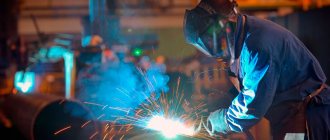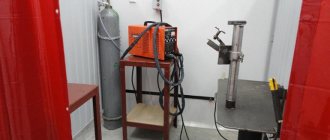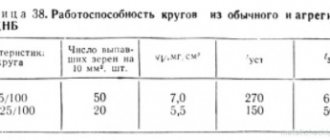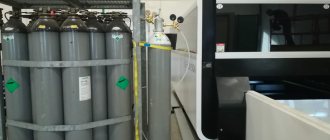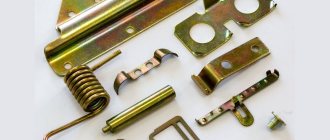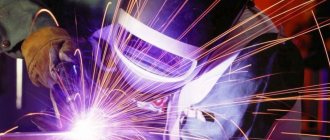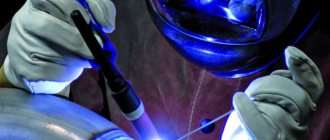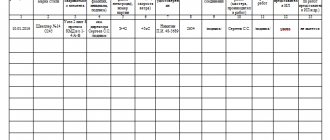The welding process involves high temperatures, open flames, and flammable gases. To avoid injury and loss of property from fires, it is necessary to adhere to fire safety rules when welding.
The risk of fires increases in confined spaces where it is difficult to move equipment around. Not everywhere there is a fire alarm, so it is useful to know what to do if a fire does occur during welding, which is important to have on hand in case of an emergency.
Fire safety during welding work is regulated by law. SNiPs and rules have been developed that not only professionals, but also novice welders must follow. Fire safety measures when carrying out welding work will help preserve your health and protect you from financial losses.
Why is it important to follow labor safety rules in the welding area?
Safety precautions during welding work are a set of organizational and other measures that are aimed at eliminating the likelihood of injury or damage to the workpiece. This is due to the high likelihood of injury. It is important to follow labor safety rules when carrying out welding work for the following reasons:
- During operation, a current is supplied, the voltage and strength of which increase. Improper handling and careless handling of the equipment may result in electric shock.
- The electric arc can affect the skin or organs of vision. This is due to the high brightness of the arc, as well as strong heat generation.
- During operation, harmful gases may be released that have a negative effect on the respiratory system. High temperatures lead to the appearance of dust and various fumes.
- Mechanical injuries may occur during welding work. This is due to the fact that large parts are often connected. They must be firmly fixed during welding.
- There is a small chance of liquefied gas cylinders exploding. In a compressed state, the substance through which welding can be carried out becomes explosive.
- The danger of radiation charging during quality control of welds.
Welding work is carried out extremely often. Therefore, certain GOSTs and regulatory documents have been adopted, which, if followed, can reduce the likelihood of injury.
Download GOST 12.3.003-86
In this article:
In case of injury at work:
When working as a private master
- a commission was appointed to investigate the causes;
- management will lose bonuses this month;
- Perhaps someone from middle management will be fired indicatively.
- explosions of flammable gases are possible;
- harmful fumes are released;
- the welder is in close proximity to hot objects or flames;
- possible electric shock;
- there are harmful effects of UV rays and bright light.
But for you without eyes or with a damaged heart from an electric shock, this is unlikely to make you feel any better. And if you are partly to blame for what happened, you will also be punished financially. Therefore, the welder himself should be interested in observing safety regulations and demand from management everything necessary for this.
To gain access to the site, an employee must?
When hiring, all future employees are subject to certain requirements. Safety precautions when welding must be observed. Among the features of employee access to the site, we note the following points:
- Knowledge of safety precautions related to the supply of electricity must be checked.
- Only persons over 18 years of age may be allowed to perform welding work and enter the work area. At the same time, they must undergo training and obtain the appropriate permit.
- Proficiency testing may be carried out from time to time.
If a future employee does not have the appropriate education and skills, then he should not be allowed to work. The welder must also prevent strangers from entering the work area, as they may also be harmed.
General requirements
Hot work is carried out during daytime working hours (the only exception may be an emergency situation requiring emergency intervention). Operating personnel are required to inspect workplaces within three hours after completion of all hot work for signs of fire, smoldering, and the formation of a smoke source. If necessary, you need to take all necessary measures to eliminate them.
In a situation where it is necessary to carry out unscheduled hot work - during non-working periods, on weekends or holidays, then these actions are allowed to be taken only after the order has been issued and announced in advance at the enterprise.
Personnel allowed to carry out hot work must have a certificate confirming their qualifications.
Each employee starting work is required to undergo training and obtain the necessary permission to proceed to unscheduled work. The admission must be accompanied by the signature of the head of the enterprise, who bears full responsibility for the operation.
The hot work area can be permanent or temporary. The sector for regular work can be a site or a workshop that includes up to 10 workplaces. Safety precautions require storing oxygen cylinders in a room separate from the work workshop. Each employee's station is equipped with only 1 spare cylinder.
The commission of the department where the planned hot work sites are located is obliged to draw up a report on the compliance of the workplace with all fire safety requirements and measures. It is accompanied by a floor plan with assignment of workplaces to equipment. This act is approved by the signature of the responsible manager, after which it is approved by an order for the enterprise.
What hazards exist on the site?
There can be quite a few different hazards on a work site. When taking them into account, safety precautions are developed. The use of special equipment determines the following:
- There is a high risk of electric shock. If welding equipment is used incorrectly, current can spread through metal workpieces.
- Welding safety precautions are developed taking into account the likelihood of heat injury. At the time of welding, the workpiece is heated to high temperatures, the metal becomes liquid. If it comes into contact with an open area of skin, a burn may occur.
- If the elements being connected are not securely fastened, injury may occur. Fixation is also required in order to obtain a high quality seam.
- The resulting arc results in a bright flash. It can cause vision damage.
- When heating metals and various alloys, harmful gases can be released, which should not enter the respiratory tract.
Injury due to poor welding safety practices
In some cases, there may be other hazards on the site. An example is the case of using a cylinder with an explosive substance.
Necessary activities
To prevent a fire, the following measures are required:
| Events | What are the |
| Organizational | Conducting briefings on safety rules at a specific site for welders assigned there |
| Technical | Preparing welding equipment, checking its functionality and grounding |
| Operational | Correct choice of operating modes |
| Regime | Elaboration of rules to ensure safety at a specific facility and familiarization of personnel with them |
Respiratory and skin protection
An arc is formed during welding work. It causes the following effects:
- Light, as the arc becomes a source of a bright flash.
- Ultraviolet. Such exposure causes pain and stinging in the eyes, and in some cases, skin burns.
- Infrared radiation causes cataract damage.
In addition, harmful gases may be released, which, if ingested, can lead to headaches, vomiting and weakness. Some harmful substances can accumulate in tissues, leading to the development of diseases.
Respiratory and skin protection
The most widely used means of respiratory and skin protection are:
- Special welding masks. They protect the face from splashes of hot metal, as well as the eyes from bright light sources. There are a wide variety of masks available on sale; they are selected depending on the conditions in which welding is carried out and the preferences of the welder.
- Installation of a local ventilation system that provides air supply and exhaust. A similar system is required when welding is carried out indoors.
- In some cases, respirators and gas masks are required.
- In some cases, toxic consumables are replaced with safer ones.
- The automation and mechanization of the process is significantly increased when using various devices.
Protective equipment for welding work
You need to pay attention to choosing quality protection. This is due to the fact that there are a large number of low-quality products on sale. Safety precautions during welding work require the mandatory use of protective masks.
Labor protection requirements before welding work
Safety precautions when carrying out welding work include preparation and inspection of equipment. This is due to the fact that it is often due to the poor technical condition of the welding inverter or consumables. That is why before carrying out work:
- The integrity of the device and auxiliary elements, as well as consumables, is inspected.
- Protective equipment must also be in good condition. Safety precautions include checking the integrity of all equipment.
- When working in hazardous conditions, scaffolding and other auxiliary structures are prepared.
- Attention is paid to grounding. It eliminates the possibility of electric shock.
- The housing of welding machines and machines must be reliably grounded. In this case, the likelihood of a short circuit occurring is significantly reduced.
- The integrity of the insulation of all cables must be checked. At the same time, they should not be in water during operation, since the reliability of the insulation is significantly reduced.
- Do not use a wire that is too long; the recommended figure is about 10 meters.
- Safe conditions are provided with a current of 12V. But in most cases, power can come from other power sources.
Safety precautions at the welding workplace
With proper preparation and safety precautions, a wide variety of problems can be avoided.
Measures aimed at preventing potentially dangerous situations
To minimize the risk of fire, prior training is required. It is important for beginners to know:
- how to reduce the risk of fire;
- how to localize a fire when it occurs;
- How to protect yourself from burns while working.
A properly organized workplace is the key to safety.
Fire extinguishing means: a fire extinguisher or a box of sand should be within walking distance; these safety measures are mandatory. Before work, technical measures are carried out: the equipment is inspected, a test run is done to select the desired operating mode.
Requirements for labor protection during welding work
Safety precautions when performing welding work must be observed to eliminate the possibility of injury. Its features include the following points:
- Do not work in rain or snow. High humidity causes increased electrical conductivity. It is allowed to carry out work under canopies.
- During welding, it is forbidden to be distracted, as the ignition and combustion process must be carefully controlled. If this safety rule is not followed, there is a high probability of damage to the workpiece.
- Special clothing that is resistant to hot metal should always be worn. In this case, the possibility of burns due to splashes on exposed skin is eliminated.
- Welding should be carried out exclusively in a special mask.
- During a long break, the equipment is disconnected from the power source. Twisting of the cable, as well as the creation of skeins, is not allowed. This is due to the fact that when current passes, an electromagnetic field can be formed. You also need to ensure that the cable insulation is not damaged. This can happen when oil or hot metal comes into contact.
- You cannot work in wet clothes and various protective elements. This is due to the fact that their electrical conductivity increases significantly, thereby increasing the likelihood of electric shock.
- It is recommended to use a respirator even when welding is carried out outdoors. On sale you can find special respirators designed for certain conditions. They provide the required protection of the respiratory tract from harmful substances and vapors.
- When working at height, you should first of all pay attention to safety devices and mounting belts. Safety precautions require the use of special equipment designed for such use.
During welding, assistance can be provided in cases where it is necessary to ensure the fixation of any element. Assistants also take safety precautions into account.
Types of fire extinguishers
Fire safety requirements imply fire extinguishing means. Fire extinguishers are powder or carbon dioxide. If electrical wiring catches fire, do not use water or liquid foam to avoid short circuits and electric shock.
Powder fire extinguishers are universal, suitable for all classes of fires; for welding they are chosen with the “D” marking. The powder component contains potassium, sodium, and phosphorus salts. White soot, talc, nepheline, and silicon compounds are used as disintegrants. Various modifications of fire extinguishers are available:
- injection (with inert gas or air);
- gas generators;
- self-acting.
Carbon dioxide is distinguished by its ability to lower the temperature when gas is released. They are reliable for gas welding and quickly neutralize oxygen. Carbon dioxide is in cylinders in a liquid state, under pressure.
Fire extinguishers are powder or carbon dioxide.
When carrying out welding work, it is prohibited
When cooking, some prohibitions must be taken into account. Let's take the following points as an example:
- Welding should not be carried out if the safety helmet is broken or cracked.
- If the hood is not working or there is poor ventilation, it is prohibited to perform various welding works. In addition, cases with high humidity are prohibited.
- In all cases, the part must be secured; you cannot cook, for example, hanging or holding it by hand.
- Do not cook in areas with flammable gases or liquids.
- Do not cook under pressure.
- The electrodes should not be kept closed for a long period. This leads to breakdown of the element, due to which the parameters of the supplied current are adjusted.
List of prohibited actions when welding
In addition, equipment with serious mechanical damage or defects, or in a faulty condition, should not be used. The condition of the equipment should be checked from time to time.
Topic 5. Gas welding and electric welding works
Question No. 1. Fire safety measures when carrying out gas welding work.
When carrying out gas welding work:
a) portable acetylene generators should be installed in open areas. Acetylene generators must be fenced and placed no closer than 10 meters from the work sites, as well as from the air intake points of compressors and fans (Fig. 1);
Rice. 1. Safe distances when carrying out gas welding work.
b) in the places where the acetylene generator is installed, posters are posted “No entry to unauthorized persons - flammable”, “No smoking”, “Do not pass with fire”;
c) upon completion of work, the calcium carbide in the portable generator should be exhausted. Lime sludge removed from the generator is unloaded into containers adapted for these purposes and poured into a sludge pit or a special bunker;
d) open sludge pits are fenced with railings, while closed ones have non-combustible ceilings and are equipped with exhaust ventilation and hatches for removing sludge;
e) fastening of gas supply hoses to the connecting nipples of equipment, burners, cutters and reducers must be secure. The hoses are tightly placed on the nipples of the water valves, but not secured;
f) calcium carbide is stored in dry, ventilated areas. It is prohibited to place calcium carbide warehouses in basements and low flooded areas;
g) in the premises of acetylene plants, in which there is no intermediate warehouse for calcium carbide, it is allowed to store no more than 200 kilograms of calcium carbide at a time, and of this amount, no more than 50 kilograms can be opened;
h) opened drums with calcium carbide should be protected with waterproof lids;
i) it is prohibited to smoke, use open fire and use spark-producing tools in places where drums with calcium carbide are stored and opened;
j) storage and transportation of gas cylinders is carried out only with safety caps screwed onto their necks. Cylinders are delivered to the place of welding work on special carts, stretchers, and sleds. When transporting cylinders, shocks and impacts are not allowed;
k) it is prohibited to store oxygen cylinders and cylinders with flammable gases, as well as calcium carbide, paints, oils and fats in the same room;
l) when handling empty cylinders of oxygen or flammable gases, the same safety measures are observed as with filled cylinders;
m) smoking and the use of open fire are prohibited within a radius of 10 meters from sludge storage areas, next to which the corresponding prohibitory signs are posted.
When carrying out gas welding or gas cutting work with calcium carbide, the following is prohibited:
a) use 1 water seal for two welders;
b) load calcium carbide of high granulation or push it into the funnel of the apparatus using iron rods and wire, and also work with carbide dust;
c) load calcium carbide into wet loading baskets or if there is water in the gas collector, and also load baskets with carbide to more than half their volume when operating “water to carbide” generators;
d) purge the hose for flammable gases with oxygen and the oxygen hose with flammable gas, and also replace the hoses during operation;
e) twist, break or pinch gas supply hoses;
f) move the generator if there is acetylene in the gas collector;
g) force the operation of acetylene generators by deliberately increasing the gas pressure in them or increasing the one-time loading of calcium carbide;
h) use copper tools for opening drums with calcium carbide, as well as copper as solder for soldering acetylene equipment and in other places where contact with acetylene is possible.
Question No. 2. Fire safety measures when carrying out electric welding work.
When carrying out electric welding work:
a) it is prohibited to use wires without insulation or with damaged insulation, as well as to use non-standard circuit breakers;
b) welding wires should be connected using crimping, welding, soldering or special clamps. The connection of electrical wires to the electrode holder, the product being welded and the welding machine is carried out using copper cable lugs fastened with bolts and washers;
c) wires connected to welding machines, distribution boards and other equipment, as well as to places of welding work, should be reliably insulated and, where necessary, protected from high temperature, mechanical damage or chemical influences;
d) it is necessary to place the cables (wires) of electric welding machines from pipelines with oxygen at a distance of at least 0.5 meters, and from pipelines and cylinders with acetylene and other flammable gases - at least 1 meter;
e) as a return conductor connecting the product being welded to the current source, steel or aluminum buses of any profile, welding plates, racks and the welded structure itself can be used, provided that their cross-section ensures safe current flow under heating conditions. The connection between individual elements used as a return conductor must be made using bolts, clamps or clamps;
f) it is prohibited to use internal railway tracks, grounding or grounding networks, as well as metal structures of buildings, communications and technological equipment as a return conductor. In these cases, welding is performed using 2 wires;
g) in fire-explosive and fire-hazardous rooms and structures, the return conductor from the welded product to the current source is made only with an insulated wire, and in terms of insulation quality it should not be inferior to the direct conductor connected to the electrode holder;
h) the design of the electrode holder for manual welding must ensure reliable clamping and quick change of electrodes, and also exclude the possibility of a short circuit of its body to the part being welded during temporary breaks in work or if it accidentally falls on metal objects. The handle of the electrode holder is made of non-flammable dielectric and heat-insulating material;
i) factory-made electrodes corresponding to the nominal value of the welding current should be used. When changing electrodes, their remains (cinders) should be placed in a special metal box installed near the welding site (Fig. 2);
Rice. 2. Cleaning up used electrodes.
j) it is necessary to ground the electric welding installation during operation. In addition to grounding the main electric welding equipment in welding installations, the terminal of the secondary winding of the welding transformer to which the conductor leading to the product is connected (return conductor) should be directly grounded;
k) cleaning of the unit and starting equipment should be done daily after finishing work. Maintenance and scheduled preventative repairs of welding equipment are carried out in accordance with the schedule;
l) arc power in installations for atomic-hydrogen welding is provided from a separate transformer. It is prohibited to directly feed the arc from the distribution network through a current regulator of any type;
m) during atomic-hydrogen welding, the torch must be equipped with automatic power cut-off and cessation of hydrogen supply in the event of a circuit break. Do not leave switched on burners unattended.
Question No. 3. Fire safety measures when carrying out work related to metal cutting.
During hot work involving metal cutting:
a) it is necessary to take measures to prevent spills of flammable and combustible liquids;
b) it is allowed to store a supply of fuel at the site of gasoline and kerosene cutting operations in an amount not exceeding the shift requirement. Fuel should be stored in a serviceable, unbreakable, tightly closed container at a distance of at least 10 meters from the hot work site;
c) before starting work, it is necessary to check the serviceability of the gas and kerosene cutter fittings, the tightness of the hose connections on the nipples, the serviceability of the threads in the union nuts and heads;
d) use fuel for gasoline and kerosene cutting operations in accordance with the existing instructions;
e) place the fuel tank at a distance of at least 5 meters from oxygen cylinders, as well as from an open fire source and at least 3 meters from the workplace, while the tank should not be exposed to flames or sparks during operation (Fig. 3);
Rice. 3. Safe distances when working with gasoline and kerosene cutters.
f) it is prohibited to operate tanks that have not passed hydrotests, have a flammable mixture leak, or have a faulty pump or pressure gauge;
g) it is prohibited to heat the cutter’s evaporator by igniting a flammable or combustible liquid poured into the workplace.
When carrying out gasoline and kerosene cutting operations, the following is prohibited:
a) have an air pressure in the fuel tank that exceeds the operating pressure of oxygen in the cutter;
b) overheat the evaporator of the cutter, and also hang the cutter vertically during operation, with the head up;
c) pinch, twist or break hoses supplying oxygen or fuel to the cutter;
d) use oxygen hoses to supply gasoline or kerosene to the cutter.
Question No. 4.
Procedure for testing and checking gas supply hoses.
Order of the Ministry of Labor of Russia dated December 23, 2014 No. 1101n “On approval of labor protection rules when performing electric welding and gas welding work” contains requirements for testing hoses:
clause 86. Before starting work on gas welding and gas cutting (hereinafter referred to as gas-flame work), workers performing these works check:
1) tightness of connection of hoses to the burner, cutter, reducer, safety devices
;
clause 107. When using hoses, the following requirements must be observed:
7) at least once a month, hoses are inspected and tested in the manner established by the employer’s local regulations.
Currently in force are also the Safety Rules when working with tools and devices (RD 34.03.204), which were approved by the USSR Ministry of Energy on 04.30.1985, by the Resolution of the Presidium of the Central Committee of Trade Unions of Power Plant Workers and the Electrical Industry of 03.27.1985, Protocol No. 42. These Rules are not registered by the Ministry of Justice of Russia and, therefore, are not a normative legal act. In this regard, the Safety Rules when working with tools and devices (RD 34.03.204) can be applied to the extent that does not contradict the Labor Safety Rules when working with tools and devices, approved by Order of the Ministry of Labor of Russia dated August 17, 2015 N 552n.
7.3.39. Gas-conducting hoses must comply with GOST 9356-75 “Rubber hoses for gas welding and cutting of metals. Technical conditions".
7.3.40*. The total length of hoses for gas welding and cutting should be no more than 30 m. The hose should consist of no more than three separate pieces connected to each other by double-sided special corrugated nipples and secured with clamps.
During installation work, the use of hoses up to 40 m long is allowed. The use of hoses longer than 40 m is allowed only in exceptional cases with the permission of the work manager and the engineer-inspector for safety and industrial sanitation.
7.3.41. Sleeves must be inspected daily before work to identify cracks, cuts, abrasions, etc.
The outer surface of the hoses should be free of peeling, bubbles, exposed areas of braid, dents and other defects that affect their performance.
7.3.42*. Hoses must be subjected to a hydraulic strength test once every 3 months. pressure equal to 1.25 p, where p is the working pressure, MPa (kgf/m2). The sleeves are maintained at this pressure for at least 10 minutes. In the presence of oily waters, it is allowed to replace the hydraulic test with a pneumatic test with air or nitrogen, purified from oil and mechanical impurities, by immersion in water. There should be no ruptures, water leakage in the form of dew, local swelling or release of air (nitrogen) bubbles on the hose.
Test results must be recorded in a journal (free form).
7.3.43*. The outer layer of hoses used for supplying acetylene, propane and butane should be red, oxygen - blue.
It is allowed to mark the outer layer of the black sleeve with two rubber colored stripes.
The width of the colored stripes and the distance between them are applied to the hoses in any form, but uniformly for all hoses available at the enterprise.
Colored stripes are applied to the sleeves at their ends with a length of at least 1 m.
Color stripes are not applied to hoses for supplying oxygen under a pressure of 4 MPa (40 kgf/cm2) with a black outer layer.
7.3.44. Before connecting to the torch or cutter, the hoses must be purged with working gas.
7.3.45. The fastening of gas-conducting hoses to the connecting nipples of burners, cutters and reducers must be reliable. For this purpose, tie clamps should be used. Instead of clamps, it is allowed to fasten the sleeves with soft annealed (knitting) wire in at least two places along the length of the nipple.
The hose connection points must be carefully checked for tightness before and during work. The sleeves on the nipples of the water valves should be placed tightly, but not fastened.
7.3.46. It is prohibited to bend or pull the sleeves during work. Sleeves must be protected from all kinds of damage, fire, etc.; intersection of hoses with steel ropes (cables), cables and electric welding wires is prohibited.
7.3.47. It is prohibited to use defective hoses or wrap them with insulating tape or other similar material.
Damaged areas must be cut out and the ends connected with a double-sided nipple and secured with tie straps. Connecting hoses with sections of smooth tubes is prohibited.
7.3.48. If the hose breaks, it is necessary to immediately extinguish the flame and stop the power supply by closing the corresponding valves.
7.3.49*. Hoses must be stored indoors at temperatures from -20 to +25 °C in coils no more than 1.5 m high or in a straightened form and placed at a distance of at least 1 m from heat-emitting devices. Before installation, hoses stored at sub-zero temperatures must be kept at room temperature for at least 24 hours.
Sleeves must be protected from exposure to direct sunlight and heat, from exposure to oil, gasoline, kerosene or their vapors, as well as from acids, alkalis and other substances that destroy rubber and thread frame.
Labor protection requirements after completion of welding work
After welding is completed, certain labor safety requirements must also be observed. Let's take the following points as an example:
- The current is switched off.
- Before checking the condition of the seam, you need to wait for it to cool completely. Safety precautions prohibit working with hot metal.
- After de-energizing the equipment, it is necessary to clean it and check its integrity.
After the seam has cooled, its integrity and quality are checked. After this, all main and auxiliary equipment is assembled.
Bitumen heating and safety
Bitumen is boiled in special boilers, installed so that the edge located above the firebox is higher than the opposite one. The boilers are equipped with a special lid. The dry boiler is filled to three quarters of its full volume.
The boiler installation site is surrounded by a non-flammable side with a height of thirty centimeters. After completing work, workers are required to extinguish the fire and fill it with water.
Fire extinguishing means should be available nearby: sand, shovels, foam fire extinguishers. If the bitumen boiler is installed outdoors, then a canopy made of non-flammable materials is installed on top.
If a leak is detected in the boiler, the fire is extinguished and all work is stopped.
Requirements for labor protection during welding work in emergency situations
Some labor protection requirements are taken into account in case of work in emergency situations when restoring critical mechanisms. Among the features we also note:
- Work cannot be carried out if the pipe is under pressure.
- Safety precautions do not allow work to be carried out near explosive substances.
- Actions must be taken to eliminate the possibility of a health hazard.
Welding during an accident in the subway
For emergency situations, special labor protection requirements may be developed that are related to the welding conditions. In conclusion, we note that the quality of the resulting product can be significantly improved by using modern equipment. Old inverters do not perform at their best, as they were manufactured using outdated technologies.

